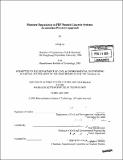| dc.contributor.advisor | Oral Büyüköztürk. | en_US |
| dc.contributor.author | Au, Ching, 1977- | en_US |
| dc.contributor.other | Massachusetts Institute of Technology. Dept. of Civil and Environmental Engineering. | en_US |
| dc.date.accessioned | 2005-09-27T19:08:14Z | |
| dc.date.available | 2005-09-27T19:08:14Z | |
| dc.date.copyright | 2005 | en_US |
| dc.date.issued | 2005 | en_US |
| dc.identifier.uri | http://hdl.handle.net/1721.1/28932 | |
| dc.description | Thesis (Sc. D.)--Massachusetts Institute of Technology, Dept. of Civil and Environmental Engineering, 2005. | en_US |
| dc.description | Includes bibliographical references (leaves 211-235). | en_US |
| dc.description.abstract | (cont.) characterization, and kink criterion implementation, form a synergistic analysis of the mechanistic debonding behavior affected by moisture. Results have shown that moisture affected debonding is a highly complex phenomenon that involves physical changes in the bond as well as in its constituent materials. In particular, moisture can initially enhance or reduce the interface fracture toughness, depending on the epoxy formulation being used. The toughness can, however, decrease by as much as 60% and become asymptotic upon reaching a certain moisture concentration threshold, which can be attained in as short as 2 weeks in case of peel fracture. While various debonding modes have been observed for dry specimens, epoxy/concrete interface separation, which has generally been considered an unlikely debonding mode, is observed consistently in all wet fracture specimens. Interface fracture analysis indicates that this newly discovered interfacial debonding mode is attributed to various interfacial material toughening or weakening mechanisms, and has also hinted on the possible interphase formation as a consequence of moisture diffusion. The new knowledge and results obtained from this research provide a basis for further analysis directions and for design of FRP bonded concrete systems against moisture affected debonding. | en_US |
| dc.description.abstract | The objective of this research is to develop new mechanistic understanding of moisture affected debonding failures in carbon fiber-reinforced plastic (FRP) bonded concrete systems by means of an interface fracture approach. Central to the investigation is the use of interface fracture toughness as the quantification parameter, which is considered a bond property, to analyze, compare, and correlate physical observations of FRP bonded concrete joints. Owing to the non-negligible epoxy bond line thickness found in real-world retrofitted systems, a new tri-layer fracture energy model is derived to facilitate the computation of interface fracture toughness values. Also, with this model, the five possible debonding scenarios in FRP bonded concrete that include interface separation and material decohesion, are quantitatively distinguished and precisely described for the first time. Debonding characterization is conducted using mesoscale peel and shear fracture models manufactured with full-scale bond lines. These models are subjected to accelerated moisture conditioning to achieve various levels of moisture content in the bond region. They are then mechanically tested at selected time intervals for capturing the change in bond property and debonding mode with respect to increasing moisture concentration, which is evaluated by means of 3-dimensional moisture diffusion simulations. Diffusion and mechanical properties of the constituent materials with respect to moisture uptake are physically determined to act as inputs in the diffusion simulation and in the computation of toughness values. The knowledge of computed toughness values, simulated diffusion behavior, and observed debonding modes, combined with finite element fracture computation, mode-mix | en_US |
| dc.description.statementofresponsibility | by Ching Au. | en_US |
| dc.format.extent | 254 leaves | en_US |
| dc.format.extent | 12930369 bytes | |
| dc.format.extent | 12963835 bytes | |
| dc.format.mimetype | application/pdf | |
| dc.format.mimetype | application/pdf | |
| dc.language.iso | en_US | |
| dc.publisher | Massachusetts Institute of Technology | en_US |
| dc.rights | M.I.T. theses are protected by copyright. They may be viewed from this source for any purpose, but reproduction or distribution in any format is prohibited without written permission. See provided URL for inquiries about permission. | en_US |
| dc.rights.uri | http://dspace.mit.edu/handle/1721.1/7582 | |
| dc.subject | Civil and Environmental Engineering. | en_US |
| dc.title | Moisture degradation in FRP bonded concrete systems : an interface fracture approach | en_US |
| dc.title.alternative | Moisture degradation in fiber reinforced plastic bonded concrete systems | en_US |
| dc.type | Thesis | en_US |
| dc.description.degree | Sc.D. | en_US |
| dc.contributor.department | Massachusetts Institute of Technology. Department of Civil and Environmental Engineering | |
| dc.identifier.oclc | 60525855 | en_US |
